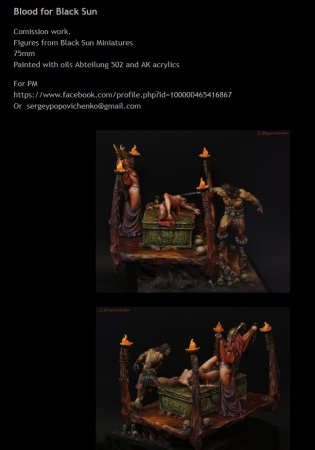In the next picture, I've applied my Dip mix. In this case, it's brown ink, matte medium, red-brown ink, and water, mixed to a consistency like runny maple syrup. It's hard for me to describe this consistency... wait! It's about the same as motor oil! I think that is a pretty good gauge to shoot for when you make your own mix. Alternatively, you can use Minwax Polyshades (dark walnut) or one of the Army Painter products (which seem a lot like Polyshades).

The beauty of the Dip is that it gives you some shading and highlights over your bland base colors! You could easily stop here and have a perfectly nice, average, tabletop quality paintjob. I'm going to go a bit further though, so read on!
Since this guy is an army centerpiece, he deserves a bit more work. After my dip solution dries, I paint a layer or two of highlights onto every area of color. I simply lighten my base color and paint a small area where the light would hit. I'm careful not to go nuts and cover up all my glorious dip work, though! The difference is subtle, but makes a big difference.

At this point, I glued the figure together. Because of the large mating surfaces and cast-on pins or lugs, no pinning was necessary. Once the glue was dry, I covered the base with white glue, dipped the thing in sand, and then pushed some small rocks (coarse ballast) into the sandy glue mix.


Once the glue on the base was dry, I started painting the base. First, I painted the sand with thinned brown. While that was drying, I painted the rocks in three stages - dark gray, light gray, white. After the paint was all dry, I applied green flock and then static grass in patches (being sure to let some dirt show through).











